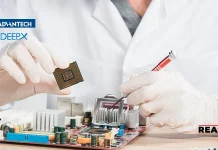Have you ever imagined a world without smartphones, laptops, or refrigerators? It would appear incomplete, wouldn’t it? But what is the building block behind these indispensable creations? They are none other than semiconductors, often overlooked yet utterly remarkable.
This extraordinary material serves as the foundation for every technological wonder, encompassing everything from smartphones to the vast realm of space exploration.
So, let’s dive into the electrifying world where small chips show unlimited possibilities beyond our imagination.
What is Semiconductor?
A semiconductor is a material with electrical conductivity that falls between that of a non-conductor and a conductor. It possesses better electrical conductivity than an insulator, although it falls short of the high conductivity levels exhibited by metals such as copper or aluminum. It is also known as chips, or semis, and is a crucial part of almost every modern electronic device. They can be found in a range of products such as smartphones, home appliances, computers, gaming hardware, and various types of medical equipment. Similarly, devices like microprocessor chips are made from semiconductor materials and are used in a wide range of electronic equipment and devices.
Key Types of Semiconductors Revolving the Tech World
Semis can be classified into two types based on the impurities added to the semiconductor material during the doping process. These types include:
● P-Type
P-type semiconductors are created by adding trivalent impurities like aluminum, boron, gallium, or indium to pure semis material. The impurities create “holes” in the crystal lattice, which act as positive charge carriers. These semis are often used in diodes, transistors, and electronic devices.
● N-Type
An n-type semiconductor is a material with pentavalent impurities like arsenic, antimony, phosphorus, or bismuth. These impurities introduce extra electrons as negative charge carriers. These types of chips are mainly used in transistors, diodes, and other electronic devices.
● Intrinsic Semiconductor
Intrinsic semis are materials that are pure and do not contain any deliberately added dopants. It exhibits balanced electron and hole concentrations and conducts electricity through the movement of both electrons and holes. It acts as an insulator at zero temperature and generates electron-hole pairs when the temperature is increased.
The behavior of p-type and n-type semis can be understood when they are combined to form a p-n junction diode. This junction is a two-terminal semiconductor device that allows the flow of electric current in one direction while blocking it in the opposite direction. It allows for the creation of diodes and other devices.
Cutting-Edge Trends Shaping the Semiconductor Landscape
Below are recent trends that are reshaping the chip manufacturing industry.
1. Rapid Integration of AI Technology
AI is being rapidly adopted and implemented on a global scale, offering enterprises a valuable opportunity to develop and integrate AI technology into chips. This AI incorporation allows businesses to minimize operational expenses and enhance manufacturing processes. The increased demand for AI-driven applications and devices has led to the expansion of opportunities for chip manufacturing companies.
Intel, the leading company in AI chip technology, has achieved a significant financial success of $1 billion with its Xeon processors. The third generation of the Xeon Platinum series features up to 40 cores, 1.6 times higher memory bandwidth, and 2.66 times increased memory capacity. It also includes Intel’s Gaudi neural network training accelerator, which is favored due to its exceptional memory capacity. Even Intel NCS2 is popular and is specially designed for deep learning applications.
2. Rise of Cellular IoT Technology
Will the rise of IoT technology reshape the semiconductor industry as a whole? IoT semis have unique features that differentiate them from traditional ones. IoT device companies are utilizing RISC-V, an open-source, energy-efficient, customizable, and secure instruction set architecture, for cost-effective, efficient resource utilization in various IoT deployments.
Huawei Technologies and Nordic Semiconductor have a patented license agreement, wherein Huawei grants a component-level license for its low power wide area (LPWA) cellular IoT standard essential patents (SEPs) to Nordic. The agreement ensures that Nordic customers have legal protection and a feasible method to incorporate Huawei’s valuable standardized cellular IoT technology. The main goal of this agreement is to promote harmony within the cellular IoT industry by adhering to fair, reasonable, and non-discriminatory (FRAND) licensing practices for SEP, benefiting Huawei, Nordic, and Nordic’s cellular IoT customers.
3. Invention of Autonomous Cars
Self-driving cars, powered by semiconductor-based chips, are set to transform the automotive sector, offering a range of collaborative features.
These advanced vehicles will optimize their performance by utilizing automotive semis, enhancing connectivity, sensors, battery efficiency in EVs, automation, and other improvements. Also, the integration of automotive AI software will significantly enhance the operational efficiency of self-driving and semi-autonomous vehicles.
BMW and Qualcomm collaborated to create advanced autonomous driving technology, providing Level 3 capabilities by the latter half of 2025. This will allow drivers to travel without manual steering or constant road monitoring, but human intervention will be required in case the system cannot operate on its own.
4. Introduction of 3D Printing
3D printing has the potential to create small and efficient chips in the manufacturing of semis. However, it is mainly used for passive components in electronics. This manufacturing method allows for the creation of parts in various shapes, leading to improved efficiency, fewer failures, and increased reliability in new facilities.
3D printing of electronic components reduces the need for a large inventory of passive components, thus decreasing reliance on the supply chain. It also helps in addressing issues like vibration, leakage, and dead zones, resulting in reduced machinery parts and weight savings.
Wrapping it Up
Semiconductors are remarkable materials that have revolutionized the world of technology and electronics. They enable precise control of electrical conduction and are the building blocks of modern electronic devices. These small chips have transformed computing, telecommunications, renewable energy, healthcare, and other fields. Semis have shaped our daily lives and driven economic growth and innovation on a global scale. As researchers and engineers continue to explore new materials, refine manufacturing processes, and improve device performance, semis will remain at the forefront of technological advancements, shaping the future.
Browse More Posts:-
Airtight Tapes Market
AFCC Debt Settlement Market
Digital Printing Wallpaper Market
String Lights Market




